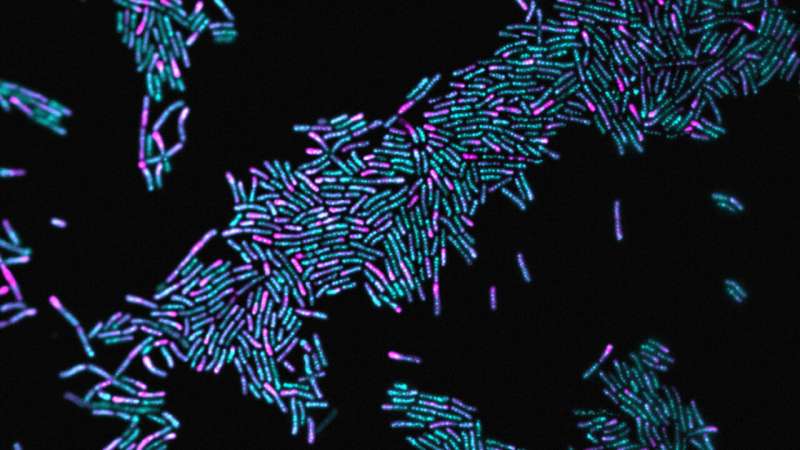This article has been reviewed according to Science X's editorial process and policies. Editors have highlighted the following attributes while ensuring the content's credibility:
fact-checked
peer-reviewed publication
trusted source
proofread
How bacteria ship cellular cargo by 'surfing' along proteins

Bacteria live in nearly every habitat on Earth including within soil, water, acidic hot springs and even within our own guts.
Many are involved in fundamental processes like fermentation, decomposition and nitrogen fixation. But scientists don't understand a fundamental process within bacteria cells: how they organize themselves before division.
Driving vs. surfing
When cells divide the cell splits into two "daughter cells" with the same genetic material as the original cell.
During this process, the DNA and other cellular components replicate, and then this "cargo" is shipped to opposite sides of the cell.
Once everything is in place, the cell splits down the middle to make two identical daughter cells.
The way eukaryotes (the cell type found in animals, plants, fungi, and some unicellular organisms) ship cellular cargo is well known. Protein motors drive along "highways" made of proteins called actin filaments and microtubules to pull DNA and organelles to opposite sides of the cell.
Bacteria don't have microtubules or actin filaments, but still manage to coordinate movement within the cell.
As a student, Anthony Vecchiarelli, Ph.D., found it astounding that "we don't know how things move within a cell for a whole domain of life."
Now an affiliate faculty member in the University of Michigan Medical School Department of Biological Chemistry and assistant professor in the University of Michigan Department of Molecular, Cellular and Developmental Biology, Vecchiarelli along with a team of researchers conducted a study to better understand organization and movement coordination within a bacterial cell.
The University of Michigan researchers found some bacteria ship cellular cargo by "surfing" along proteins called ParA/MinD ATPases.
These proteins, or "positioning systems," are even dedicated to shipping a single cellular component—each cargo has its own dedicated "surfboard."
These movements, or "positioning reactions," can influence one another, giving a clue to how bacteria coordinate complex movements in the cell prior to its division.
The results are published in Nature Communications.
A model bacteria
To achieve this, the research team first had to find a bacterium to study because the model species typically used in research to understand biological processes don't have many positioning systems.
"A lot of the models that we use to understand how bacteria work suggested that there wasn't really any intricate organization for all of these cargos," said Vecchiarelli.
"There are some bacteria like plain old E. coli that seems to segregate its chromosomes without an active segregation system."
Using bioinformatics techniques to sift through genetic information across bacteria was the first step to determine the prevalence of active positioning systems.
"We found over a third of all sequenced bacteria do encode for multiple positioning systems for multiple disparate cargos in the same cell. E. coli is an exception to the norm," Vecchiarelli said.
The research team selected a bacteria called Halothiobacillus neapolitanus to study as it has seven different positioning systems for seven different cargos.
Vecchiarelli's graduate student, Lisa T. Pulianmackal, learned how to cultivate this bacterial species in the lab and fluorescently label five cargos, allowing the researchers to follow their movement in live cells through cell growth and division.
She then deleted each positioning system to show how each one is dedicated to a specific cargo.
The next step was the systems level approach to see how these cargo movements interact with one another.
Systems biology approach
Often, researchers focus on a single biological process. They make a mutation and then see if that specific process was influenced. This approach can miss indirect consequences of that mutation.
This study is one of the first to use a systems biology approach on spatial organization in a bacteria cell.
"We find that there is a lot of crosstalk, interdependencies, and coordination among these organizing processes," Vecchiarelli said. "That's why the systems biology approach is so important."
Future applications
The results offer exciting new prospects in biotechnological developments.
Each positioning system is made of an ATPase and its adapter protein, or surfboard, which connects to the cargo. This offers an opportunity to develop a synthetic biology tool allowing researchers to position any cargo they choose by connecting to the adapter.
"Now that we identified five different positioning systems that work together, we are hoping to develop a synthetic biology toolset for positioning a wide variety of synthetic as well as natural cargos in bacteria for biotechnological applications," Vecchiarelli explained.
Researchers also plan to investigate cargo movement in medically relevant microbes like pathogens, or disease-causing bacteria.
"For bacterial pathogens, understanding how to break the surfboard can help us design new antibiotics," Vecchiarelli said.
More information: Lisa T. Pulianmackal et al, Multiple ParA/MinD ATPases coordinate the positioning of disparate cargos in a bacterial cell, Nature Communications (2023). DOI: 10.1038/s41467-023-39019-x
Journal information: Nature Communications
Provided by University of Michigan





















